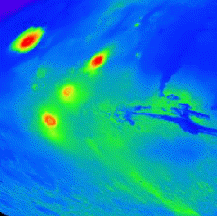This drawing shows the possible geography of Martian water.
Click on image for full size
NASA
The Transfer of Water in Martian History
The unusual global geography of Mars helps to explain the fact that water has been drawn from the southern hemisphere to the northern hemisphere of the planet through all of Martian history (that is, from higher ground to lower ground, where lower ground is in the northern hemisphere of the planet).
On a cold planet water can be trapped, frozen, within the ground, providing a source of flowing water on the ground only when the water is melted. The question is, what causes the frozen ground water to be melted and released to the surface? Opening of the aquifer can occur in a number of ways. Among them are
- volcanism, where ice is melted along the slopes of the volcano during volcanic events,
- climatary warming, where near surface ice is catastrophically released during periods of warmer temperatures.
Much of the evidence for running water on Mars shows that the water is being drawn to lower latitudes, including evidence that water flowed down the edges of the steep slopes at the boundary between the Martian highlands and the Martian lowlands. This evidence is in the form of icy flows, i.e. glacial features, suggesting that there is icy flow towards the lowlands from the highlands.
You might also be interested in:

The Martian geography is one of high altitudes at high southern latitudes and low altitudes at low latitudes. The ground is less frozen at low latitudes because it is warmer and water can evaporate. Thus,
...more
This is the first image showing clouds of Mars taken from the lander. Ground based viewing of Mars has shown that clouds seem to be plentiful only in the middle latitudes This may be because water of Mars
...more
On this map of Mars, the lightly cratered Tharsis Ridge is shown, as well as the heavily cratered Martian highlands (near the bottom of the picture), and Valles Marineris to the right. The volcanoes are
...more
The unusual global geography of Mars helps to explain the fact that water has been drawn from the southern hemisphere to the northern hemisphere of the planet through all of Martian history (that is, from
...more
Separate from the Martian outflow channels, or the river valley networks, are large Martian lakes (600 km, or ~1000 miles across) which exhibit evidence of a periodic and catastrophic release of water
...more
This is an image of fog in a Martian canyon. The presence of fog provides evidence of water, and a water cycle on Mars. More fog has been seen in images returned by Mars Global Surveyor of the south polar
...more
The Martian climate is more influenced by the shape of the Martian orbit than the climate of the Earth is influenced by the shape of the Earth's orbit. The orbit of Mars is more elliptical than that of
...more
This is an image of a storm moving across the Martian terrain. The camera is looking down upon the storm and the storm front forms a spiral pattern, the same way terrestrial storms are presented on the
...more













